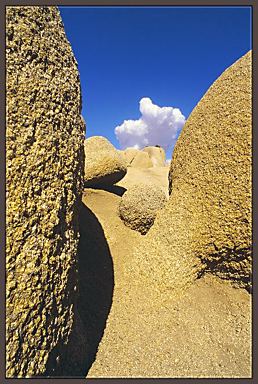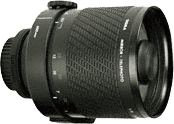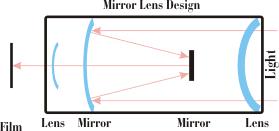There is a huge array of
different lenses available for your DSLR.
Which one(s) should you consider buying?? Well,
let's review the purpose of each lens and then we'll get into the
practicalities of lens buying.
Important Concepts...
Lenses are designed to excel at a particular task. Some
are very good at getting sharp close-up pictures, some are good at
magnifying while others are very
good at controlling distortion. No lens can "do it all".
Several important qualities of a lenses include how sharp they are, how
much they magnify, how well they can record color and contrast, etc.
There can be great differences between, what appears to be, similar
lenses.
The further a lens is moved away from the film, the more
magnification takes place at the cost of lost light - i.e., less light
will reach the sensor.
All lenses have flaws or "aberrations" - better quality
lenses don't exhibit them as much. For example, some lenses can't
focus all colors on the same plane. Therefore some colors will be
in focus, while other colors won't. This can be a serious flaw in
a lens and almost all lenses suffer from this to one degree or another.
Some lenses are designed to focus all colors on
the same plane.
Different lenses record color and contrast differently.
Better lenses often deliver higher-contrast, more pleasing images than
poorer lenses. Same thing with colors and color saturation.
Important Terms...
It's important to understand the terminology that surrounds
lenses. The first important term is Focal Length.
Focal length can be defined as the distance from the
sensor to the optical center of the lens. What if you were to take a
magnifying glass and position it about one inch from some text.
How much magnification would there be? Now, position it 2 inches
from the text - more magnification. Now position it 10 inches from
the text - it's now completely out of focus. Voila, the concept
behind Focal Length! The further you move the magnifying glass
from the text, the bigger it gets. Some lenses are designed to
be further from the sensor and some lenses are designed NOT to be further
from the sensor. The further you move a lens from the
sensor, the more magnification you get. Longer focal length lenses
(lenses which are designed to have their optical centers positioned
further from the sensor) provide more magnification. Shorter focal
lenses provide less magnification.
Lenses can be broken down into the following broad categories:
 |
Wide Angle |
 |
Normal |
 |
Telephoto |
 |
Zoom |
 |
Macro |
 |
Tele-extender |
Wide angle lenses
Wide angle lenses probably offer the best usefulness for
general picture taking, vacation pictures, etc. And they are the easiest to
get good pictures with. This class of lens
can have focal lengths from about 35mm down to about 6mm. When you
get to the very short focal lengths, you end up with "fish-eye" lenses -
lenses that can actually see 180° (or more!) from the front of
the lens. This can result in a round image. Most wide angle
lenses fall into the focal length range of about 35mm to 20mm. The
shorter the focal length, the less magnification and the more the lens
can "see". This is measured in the "angle of acceptance".
Some samples are:
| Wide angle lenses magnify less than a "normal"
lens and tend to exaggerate perspective, thus giving a picture
more interest. They work especially well with foreground
objects. By placing the rock to the left in this image, the
picture has a lot more interest. A "normal" lens wouldn't be
able to capture that wide of a scene and the perspective of the
foreground rock wouldn't have the appeal that it does in this
image. The scene has much more depth with a wide angle lens
than it would have had with a "normal" lens.
|
 |
For taking pictures of groups of people or landscapes, wide angle
lenses are invaluable. But you don't want to go TOO wide.
Since wide angle lenses tend to exaggerate perspective, you have to be
careful with these lenses when taking picture of vertical objects (like
people!). A focal length of 28mm or 35mm is a very good lens for
taking groups of people. They can "see" a wide area (i.e., the
group of people) but they don't often visibly distort vertical lines. Be
careful with 20mm or below though.
For landscape pictures, my personal favorite is between 17mm and
24mm. Those focal lengths are wonderful for landscapes. Also,
remember that wide angle lenses provide GREATER depth of field than
normal or telephoto lenses which can be a benefit for landscape pictures
A couple of warnings about VERY wide angle lenses (i.e., 24mm and
below):
 |
Be careful about vertical lines, especially at
the edge of the picture. |
 |
Be careful using filters as the possibility of
vignetting exists - that is the filter could extend into the angle
of view of the lens and cut off the corners. |
 |
Be careful using polarizing filters since
polarizing filters work best when 90° from
the light source, wide angle lenses can see such a wide area that
you'll get varying degrees of polarization within the scene. |
"Normal" lenses
There's nothing "normal" about a "normal" lens! Normal
lenses are determined by the sensor size. This concept started with film - if you
were to measure the diagonal
of the film image, you will get the approximate focal length for a
"normal" lens.
For a 35mm negative, that's about 43mm. Here are
some "normal" focal lengths:
| Film/Sensor size |
Diagonal
(Normal lens
focal length) |
| Full Frame 35mm |
43mm |
| 2¼" x 1.8" (645) |
70mm |
| 2¼" x 2¼"(6x6) |
79mm |
| 2¼" x 2¾"(6x7) |
89mm |
As you can see, a normal lens for 35mm film is about
43mm - usually rounded up to either 45mm or 50mm. The normal lens
for a 120 negative that shoots a format that's 2¼"
square is about 80mm, etc.
What makes this a "normal" lens?? Not much. I guess it
has something to do with the magnification is about that of the human
eye. But for photography purposes, "normal" lenses are anything
but normal!! Don't get me wrong, there's nothing wrong with them, but
they tend to produce flat pictures without much pizaz. Wide angle
and telephoto lenses provide much more interest in a picture because
they tend to either open or compress perspective.
"Telephoto" lenses
Telephoto lenses magnify. In order to do this, they
must be placed further from the sensor and they must be capable of
focusing an image on the sensor from this further distance. In
addition, because the lens has to be moved a further distance from the
sensor, additional light is lost between the time it enters the lens and
strikes the sensor. Because of this, they tend to be physically
large. To give you an idea of HOW large, here are some statistics
from Nikon lenses:
| Focal length |
Weight |
Length |
| 105mm/f4 |
1 lb 3 oz |
3.3" |
| 200mm/f4 |
2 lb 10 oz |
7.6" |
| 300mm/f4 |
4 lb 1 oz |
8.8" |
| 500mm/f4 |
7 lb 10 oz |
15.6" |
| 600mm/f4 |
10 lb 7 oz |
17.0" |
I won't go into the cost, but the 600mm/f4 can cost as much as a
small car! Telephoto lenses are tempting - but they're generally
more expensive, less useful and much more difficult to use than wide angle lenses.
Short telephotos (i.e., 85mm - 135mm) are excellent for
portraits of people. They slightly compress perspective which is a
good thing in portraits. If you take a portrait with a wide angle
lens, the person might come out with a big nose (even if they don't have
a big nose). This is because wide-angle lenses expand perspective.
Since telephoto lenses compress perspective, short telephoto lenses make
people look very "normal" and pleasing (although there are some people
which NO lens can help! :-)
Long telephotos can be used for photographing wildlife at a
distance. But be aware, that it takes a BIG telephoto to
photograph most wildlife - unless it's very near and big (and generally, that's a
situation you want to avoid!!).
Depending upon the situation, I've been able to successfully use a 300mm
lens to photograph large birds (herons, etc.) at close distances.
If they are not unusually close, a 600mm lens is usually not enough!
Most bird photographers use between 600mm and 1200mm focal length lenses
to do their work. For most of us, the cost would be prohibitive!
| There is an alternative to very pricey telephoto
lenses: The Mirror (or catadioptric)
Lens =>
Mirror lenses work on the same principle as reflecting
telescopes and is one of the oldest lens designs, dating back to
Leonardo DaVinci. They use mirrors to bounce the light back
and forth inside the lens and then forces it through a small
correction lens before it reaches the sensor.
There are two "Pluses" to these lenses: They are cheap
and they are small/light.
The disadvantages are that they are manual focus, have a small
fixed f-stop (usually f8 or f11) that can't be changed, are generally are
not as sharp as prime lenses of the same focal length and create
"donuts" from out-of-focus highlights, which many people find
objectionable.
Most people who crave a long telephoto (600mm - 1000mm)
generally try one of these (as I did). They usually sell
them shortly after trying them, though. So, if you want to
try one of these, my advise would be to buy it used - there are a
lot of them around - and then, if you sell it, it wouldn't have
been a costly affair!
|


|
"Zoom" lenses
Zoom lenses span several focal lengths. Their special
design allows them to "zoom" from one focal length to another and all in
between.
Zoom lenses provide a lot of utility, but do have drawbacks. On
the plus side, you can use one lens for most of your photography.
On the other hand, zoom lenses are often slower (i.e., largest lens
aperture is often smaller) than prime (non-zoom) lenses. This
smaller aperture means they're harder to view thru as there's less light
in the viewfinder and focusing can be more difficult.
Performance-wise, zoom lenses can be close to that of a prime lens, but
are rarely as good. The low-end zoom lenses sold by most major
manufacturers (Nikon, Canon, etc) are often very poor quality lenses
that they sell very inexpensively. Good quality zoom lenses can be
quite expensive.
Depending upon your needs, you may find a zoom lens very useful.
Zoom lenses can be classified into several categories:
Zoom
Category |
Sample Focal
Length Range |
| Ultra-wide |
17mm - 35mm |
| Standard |
24mm - 85mm |
| Telephoto Zoom |
70mm - 210mm |
| "Do it all" zooms |
18mm - 200mm |
The ultra-wide zoom lenses do well for landscape photography.
The standard zoom lenses usually cover a range from wide-angle
to short telephoto. They are often good all-around lenses.
The telephoto zoom cover a range that may or may not be useful
to you. If you were do people-portraits, you really wouldn't need
a zoom lens, but a fixed-focal length lens of about 100mm. If you
want to take wildlife photographs, a telephoto zoom wouldn't be much use
unless you zoomed all the way in - in which case, you wouldn't need a
zoom lens! If you do both people portraits and wildlife, they may
be a worthwhile lens for you.
The Do-it-all zoom lenses are usually a poor choice unless you
don't want to have to carry more than one lens. They often cover a
very large range of focal lengths and usually aren't very high quality.
There's a physical design problem in trying to create one lens to do everything
well. These lenses are a compromise at best.
"Macro" lenses
Macro lenses have the ability to focus very close to a
subject - so close, in fact, that the image that is formed on the sensor
is about the same size as the real-life image. This is referred to
as a "one-to-one" macro - where the subject and image are the same size.
Macro lenses are designed to focus close up and do that best. When
asked to take a picture at infinity, they can usually do it, but won't
do it as well as close-up photography.

There are other ways of getting close-up pictures including extension
tubes, bellows, close-up add-on lenses, etc.
"Tele-extender" lenses
Tele-extender lenses are the poor-persons telephoto!
It's an attachment that fits between the camera body and your lens.
Since it extends the lens further from the film, it increases
magnification but reduces the amount of light that reaches the film.
So, it has the effect of increasing the focal length, but at the cost of
reducing the effective maximum aperture of the lens. Most tele-extender
lenses either magnify an additional 1.4 or 2 times. A 1.4x tele-extender
causes a loss of one f-stop of light while a 2x tele-extender causes a
loss of 2 f-stops. Here's the effect:
| Starting lens |
Tele-
extender |
Effect |
| 100mm/f4 |
1.4x |
140mm/f5.6 |
| 100mm/f4 |
2x |
200mm/f8 |
| 400mm/5.6 |
1.4x |
560mm/f8 |
| 400mm/5.6 |
2x |
800mm/f11 |
| Zoom 100mm-300mm/f4-f5.6 |
1.4x |
140mm-420mm/f5.6-f8 |
| Zoom 100mm-300mm/f4-f5.6 |
2x |
200mm-600mm/f8-f11 |
There is almost always a decrease in sharpness and, in some cases, the loss of auto-focus. But they are an inexpensive way to increase your
telephoto capability as well as to increase the versatility of your
lenses.
Practically speaking...
How do you get the most bang for your buck?? You can pick up a
used lens that will take the same picture as a brand new lens.
Almost all of my equipment was purchased used. Photographer's are a
"flighty" group - some are constantly "trading up". There's always a
lot of used equipment available.
Watch, read and ask questions on the Internet news groups for
information on a piece of equipment you're thinking of buying - and don't
consider any one response too highly!
|